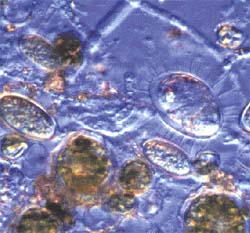The toll rises
 Certain amounts of acid rain can be buffered by the ecosystem without suffering any serious problems. However, the buffering capacity of ecosystems is finite and varies from one system to another. The effects mentioned in the IIT study by Manju Mohan and Sanjay Kumar are listed below:
Certain amounts of acid rain can be buffered by the ecosystem without suffering any serious problems. However, the buffering capacity of ecosystems is finite and varies from one system to another. The effects mentioned in the IIT study by Manju Mohan and Sanjay Kumar are listed below:
ON VEGETATION l A plant's water intake is most effective with a soil pH of 6 and above. For plant growth, important nutrients are easily available and the most harmful metals are least absorbed at this pH.
l According to Suren Choksi, a geologist based in Vadodara, Gujarat, acid rain attacks the bacteria in the soil which play an active role in the reproductivity of plants. It also prevents essential nutrients such as potassium, calcium and magnesium from being used by plants.
l The photosynthesis process, which produces food and releases oxygen in the atmosphere, can be hindered.This takes place when the protective layer of wax on leaves or needles is corroded by the acidic deposition.
l Besides, the ability of the plant to resist pest attacks can be impeded. Acid rain quickly erodes the top-soil, ridding the earth of nutrients needed by plants.
ON AQUATIC LIFE l Algae communities in freshwater lakes undergo a change in their composition (below pH6) as the species of green algae are eliminated by the increasing acidity. This relieves competition and allows more tolerant and previously less common acid-tolerant species to build up their populations.
l In certain lakes a submerged aquatic moss and attached algae spread rapidly at the expense of acid-sensitive species. These sensitive species suffer adversely and get eliminated. In general, bacteria, intolerant of acid stress, are also eliminated.
l Swedish workers have observed thick fungal mats over the sediments in some acidified lakes. The sediment-water interaction is greatly reduced by the growth of fungal mats, moss populations at the bottom of lakes, and attached algae. This hinders nutrient release from the sediments and the lake waters become progressively nutrient-deficient.
l The presence of ions of aluminium in acid rain is highly toxic to many organisms. When fish die, their prey (like beetles and dragonfly larvae) thrive and become pests.
ON AVIAN SPECIES l Among birds, the process of eggshell formation is disturbed. In the 1970s, when defective eggshells were first noticed, it was assumed that the birds were absorbing too much aluminium. But scientists soon realised that the ratio of calcium and aluminium was an important factor. Calcium deficiency is known to hinder successful hatching of a variety of bird species.
ON HUMANS l Acidic rainwater liberates mercury from the soil which can hinder brain development during the foetal stage. Fish-eating birds and humans acquire mercury by eating fish with high levels of the metal in them. The fish in turn ingest microorganisms which consume mercury released by acid rain in the water.
l Acid rain also releases aluminium and cadmium. Cadmium can cause kidney disorders, besides accumulating in the outer layer of the kidney, causing wounds.
l Aluminium on the other hand, causes problems for kidney patients. In dialysis - the process of purifying the blood when the kidneys malfunction
Related Content
- Seventh Ghana economic update: price surge- unraveling inflation’s toll on poverty and food security
- Status of mortality and economic losses due to weather, climate and water extremes (1970-2021)
- Making adaptation work: addressing the compounding impacts of climate change, environmental degradation and conflict in the Near and Middle East
- State of the global climate 2021
- The global health cost of PM2.5 air pollution: a case for action beyond 2021
- State of the climate in Asia 2020
